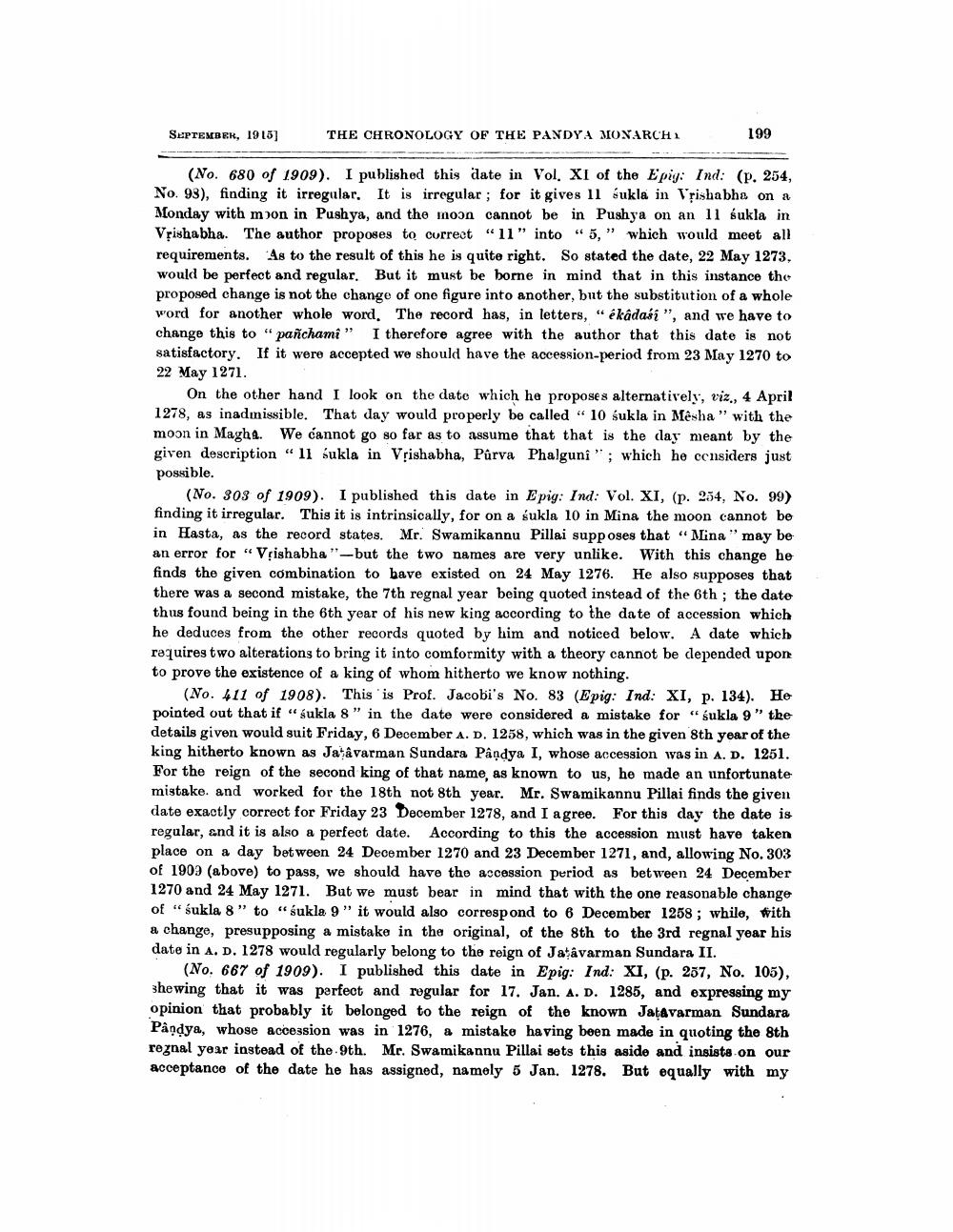________________
SEPTEMBER, 1915]
THE CHRONOLOGY OF THE PANDYA MONARCH1
199
(No. 680 of 1909). I published this date in Vol. XI of the Epig: Ind: (p. 254, No. 93), finding it irregular. It is irregular; for it gives 11 Sukla in Vrishabha on a Monday with moon in Pushya, and the moon cannot be in Pushya on an 11 sukla in Vrishabha. The author proposes to correct "11" into "5," which would meet all requirements. As to the result of this he is quite right. So stated the date, 22 May 1273. would be perfect and regular. But it must be borne in mind that in this instance the proposed change is not the change of one figure into another, but the substitution of a whole word for another whole word. The record has, in letters, "ékâdasi", and we have to change this to "pañchami" I therefore agree with the author that this date is not satisfactory. If it were accepted we should have the accession-period from 23 May 1270 to 22 May 1271.
On the other hand I look on the date which he proposes alternatively, viz., 4 April 1278, as inadmissible. That day would properly be called 10 śukla in Mêsha" with the moon in Magha. We cannot go so far as to assume that that is the day meant by the given description "11 śukla in Vrishabha, Purva Phalguni"; which he considers just possible.
(No. 303 of 1909). I published this date in Epig: Ind: Vol. XI, (p. 254, No. 99) finding it irregular. This it is intrinsically, for on a sukla 10 in Mina the moon cannot be in Hasta, as the record states. Mr. Swamikannu Pillai supposes that "Mina" may be an error for "Vrishabha"-but the two names are very unlike. With this change he finds the given combination to have existed on 24 May 1276. He also supposes that there was a second mistake, the 7th regnal year being quoted instead of the 6th; the date thus found being in the 6th year of his new king according to the date of accession which he deduces from the other records quoted by him and noticed below. A date which requires two alterations to bring it into comformity with a theory cannot be depended upon to prove the existence of a king of whom hitherto we know nothing.
(No. 411 of 1908). This is Prof. Jacobi's No. 83 (Epig: Ind: XI, p. 134). He pointed out that if "sukla 8" in the date were considered a mistake for "sukla 9" the details given would suit Friday, 6 December A. D. 1258, which was in the given 8th year of the king hitherto known as Jatavarman Sundara Pandya I, whose accession was in A. D. 1251. For the reign of the second king of that name, as known to us, he made an unfortunate mistake. and worked for the 18th not 8th year. Mr. Swamikannu Pillai finds the given date exactly correct for Friday 23 December 1278, and I agree. For this day the date is regular, and it is also a perfect date. According to this the accession must have taken place on a day between 24 December 1270 and 23 December 1271, and, allowing No. 303 of 1909 (above) to pass, we should have the accession period as between 24 December 1270 and 24 May 1271. But we must bear in mind that with the one reasonable change of "sukla 8" to "sukla 9" it would also correspond to 6 December 1258; while, with a change, presupposing a mistake in the original, of the 8th to the 3rd regnal year his date in A. D. 1278 would regularly belong to the reign of Jatavarman Sundara II.
(No. 667 of 1909). I published this date in Epig: Ind: XI, (p. 257, No. 105), shewing that it was perfect and regular for 17. Jan. A. D. 1285, and expressing my opinion that probably it belonged to the reign of the known Jatavarman Sundara Pandya, whose accession was in 1276, a mistake having been made in quoting the 8th regnal year instead of the 9th. Mr. Swamikannu Pillai sets this aside and insists on our acceptance of the date he has assigned, namely 5 Jan. 1278. But equally with my




